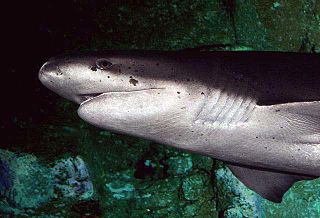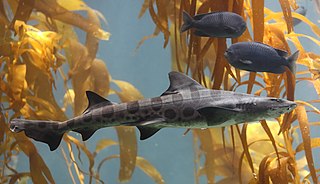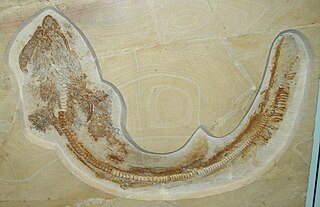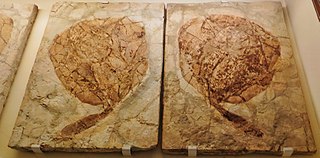
Carcharhiniformes, commonly known as ground sharks, are the largest order of sharks, with over 270 species. They include a number of common types, such as catsharks, swellsharks, and requiem sharks.

Scyliorhinus is a genus of catsharks in the family Scyliorhinidae. This genus is known in the fossil records from the Cretaceous period, late Albian age to the Pliocene epoch.

The Hexanchiformes are a primitive order of sharks, numbering just seven extant species in two families. Fossil sharks that were apparently very similar to modern sevengill species are known from Jurassic specimens.

Chlamydoselachus is a genus of sharks and the sole extant member of the family Chlamydoselachidae, in the order Hexanchiformes. It contains two extant and four extinct species. The most widely known species still surviving is the frilled shark. It is known as a living fossil, along with Chlamydoselachus africana, also known as the southern African frilled shark, which is only found along coastal areas of South Africa. The only two extant species of this genus are deep-sea creatures which are typically weakened in areas closer to the surface. While the two extant species are similar in external appearance, they differ internally.

The school shark is a houndshark of the family Triakidae, and the only living member of the genus Galeorhinus. Common names also include tope, tope shark, snapper shark, and soupfin shark. It is found worldwide in temperate seas at depths down to about 800 m (2,600 ft). It can grow to nearly 2 m long. It feeds both in midwater and near the seabed, and its reproduction is ovoviviparous. This shark is caught in fisheries for its flesh, its fins, and its liver, which has a very high vitamin A content. The IUCN has classified this species as critically endangered in its Red List of Threatened Species.

The Triakidae or houndsharks are a family of ground sharks, consisting of about 40 species in nine genera. In some classifications, the family is split into two subfamilies, with the genera Mustelus, Scylliogaleus and Triakis in the subfamily Triakinae, and the remainders in the subfamily Galeorhininae.

Ginglymostoma is a genus of shark in the family Ginglymostomatidae. There are two members in the genus. Members of this genus eat small fish and crustaceans, and are commonly quite lethargic unless provoked. Members of this genus have the ability to suck in water in order to remove snails from their shells in a manner that can be described as 'vacuum-like'.

Paraorthacodus is an extinct genus of shark. It a member of the family Paraorthacodontidae, which is either placed in Hexanchiformes or in Synechodontiformes. It is known from over a dozen named species spanning from the Early Jurassic to the Paleocene, or possibly Eocene. Almost all members of the genus are exclusively known from isolated teeth, with the exception of P. jurensis from the Late Jurassic-Early Cretaceous of Europe, which is known from full body fossils from the Late Jurassic of Germany, which suggest that juveniles had a robust body with a round head, while adults had large body sizes with a fusiform profile. There was only a single dorsal fin towards the back of the body without a fin spine. The dentition had teeth with a single large central cusp along with shorter lateral cusplets, which were designed for clutching. The teeth are distinguished from those of Synechodus by the lateral cusplets decreasing in size linearly away from the central cusp rather than exponentially as in Synechodus.

Cylindracanthus is an extinct, enigmatic genus of marine ray-finned fish with fossils known throughout North America, Europe, Asia and Africa from the Late Cretaceous to the late Eocene, with potential Oligocene records and a possible Miocene record also known. It is exclusively known from its distinctive partial remains, which are long cylindrical bony spines that are usually considered rostrum fragments, as well as some associated teeth. These spines are abundant & widespread throughout this timespan, and are useful indicators of a nearshore marine environment, but the taxonomic identity of the fish is still highly uncertain and debated.

Anacoracidae is a family of extinct mackerel sharks that lived during the Cretaceous. It includes four valid genera: Nanocorax, Ptychocorax, Scindocorax, and Squalicorax. Two previously-included genera, Galeocorax and Pseudocorax, were reassigned to the family Pseudocoracidae.
Gladioserratus is an extinct genus of cow shark. It contains three species:

Meristodonoides is an extinct genus of hybodont known from the mid-late Cretaceous, with potential records dating back to the Jurassic. It is one of a number of hybodont genera composed of species formerly assigned to Hybodus.

Synechodontiformes is an extinct order of prehistoric shark-like cartilaginous fish, known from the Permian to the Paleogene. They are considered to be members of Neoselachii, the group that contains modern sharks and rays.

Xiphodolamia is a rare extinct genus of mackerel shark which lived during the Eocene epoch. It is the only known member of the extinct family Xiphodolamiidae. It is only known from isolated teeth, but has been found in Europe, Africa, and Asia. It is assumed to be pelagic, occurring more frequently in deeper water deposits, most notably the London Clay and Eocene deposits in Denmark. It is distinguished by its rectangular root and twisted blade, unique among mackerel sharks. It is unclear what niche this specialized dentition helped exploit.

Arechia is an extinct genus of stingaree from the Paleogene epoch. It is known from two species that inhabited the northern Tethys Ocean during the Early Eocene. Isolated teeth of this genus are also known, potentially as late as the Early Oligocene.
Rolfodon is an extinct genus of shark in the family Chlamydoselachidae. It is closely related to the extant frilled sharks in the genus Chlamydoselachus, which it can be differentiated from by tooth morphology. It is named after late Canadian paleontologist Rolf Ludvigsen.

Protosqualus was a genus of dogfish shark that existed during the Cretaceous. Fossils have been found in Europe, East Asia, Antarctica, Australia, India and South America. The type species is Protosqualus sigei, which was found around an Albian aged deposit in France. There are 6 species which can be differentiated by distinct features in their teeth. Some species show some level of heterodonty, for example Protosqualus barringtonensis shows a rather high level of heterodonty within its teeth. The oldest specimens are from the Speeton Clay Formation. Protosqualus teeth are quite common in the Grey Chalk deposit of England. The genus went extinct at the end of the Cretaceous during the Cretaceous–Paleogene extinction event, with the last species in the genus being Protosqualus argentinensis from southern Argentina as well as possibly being from earlier deposits in India.
Protocentrophorus is a genus of was a genus of dogfish shark that existed during the Cretaceous. Fossils have been found in the Tauragė County of Lithuania and British Columbia in Canada. Known from teeth, they were originally assigned to the genus Centrophorus.

Sphyraena bolcensis is an extinct species of prehistoric barracuda known from the Eocene. It is known from the late Ypresian-aged Monte Bolca site of Italy.

Galeorhinus cuvieri is an extinct species of houndshark known from the Early Eocene-aged Monte Bolca site of Italy. It was a close relative of the modern tope or school shark, which it is highly morphologically similar to.


















